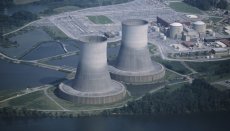Two environmental Problems
 Nuclear power offers a number of advantages over other electricity generation methods. An operating nuclear plant can produce energy without the noxious air pollution of fossil fuel generation and offers more reliability and capacity than many renewable technologies. But nuclear power comes with a pair of environmental dangers that have so far limited its widespread use, at least in the United States.
Nuclear power offers a number of advantages over other electricity generation methods. An operating nuclear plant can produce energy without the noxious air pollution of fossil fuel generation and offers more reliability and capacity than many renewable technologies. But nuclear power comes with a pair of environmental dangers that have so far limited its widespread use, at least in the United States.
Nuclear Waste
The waste from nuclear power plants falls into two categories. High-level waste is the leftover fuel from the reactor after the reaction is finished, and it is extremely dangerous and can remain so for hundreds or even thousands of years. Low-level waste includes safety gear and incidental items that have picked up radioactive contamination but enough to remain dangerous to human life. Both types of waste require storage until the radioactive material decays enough to become harmless, requiring secure containment facilities that will last centuries.
Nuclear Accidents
In addition to the waste produced by reactors under normal conditions, another major ecological danger is an accidental release of radiation. One common source of radiation leaks is the water system that plants use to generate electricity. A faulty valve can release radioactive water or steam into the environment, potentially contaminating the surrounding area. In more severe cases, accidents with fuel or control rods can damage reactor cores, potentially releasing radioactive materials. The Three Mile Island incident in 1979 released a small amount of radioactive gas into the area surrounding the plant, but the overall exposure to citizens was less than they would receive from a chest x-ray.
Catastrophic Failures
Of course, the major concern about nuclear reactors is the possibility of a catastrophic failure. In 1986, the operators of the Chernobyl nuclear reactor near Pripyat, Ukraine, initiated a safety test under dangerous conditions, and the procedure overheated the reactor and caused an enormous steam explosion and fire, killing many of the first-responders sent to deal with the disaster. The catastrophe also released a significant amount of radiation into the surrounding town, and it remains uninhabitable more than two decades later. In 2011, a tsunami and earthquake in Japan damaged the Fukushima nuclear plant, causing a partial meltdown that required the evacuation of the nearby area and released contaminated water into the nearby ocean.
Design Evolution
All of these concerns are exacerbated by the fact that most nuclear plants in operation today are decades old, and some are operating well beyond their expected lifespan. The reason for this is largely due to public opposition to nuclear energy, making it difficult for companies to construct new plants. Unfortunately, this resistance is somewhat counterproductive because modern reactor designs feature better safety systems and produce significantly less waste than older reactors. In fact, modern thorium reactors can actually use spent fuel from older reactor designs, consuming this problematic toxic waste to produce energy.




